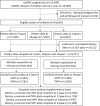Associations of childhood diet quality scores with arterial stiffness and carotid artery intima-media thickness in adolescence/early adulthood: findings from the ALSPAC cohort
- PMID: 38178807
- PMCID: PMC10803818
- DOI: 10.1017/S0007114523002763
Associations of childhood diet quality scores with arterial stiffness and carotid artery intima-media thickness in adolescence/early adulthood: findings from the ALSPAC cohort
Abstract
This study examined the relationship between childhood diet quality and arterial stiffness and thickness during adolescence/early adulthood. Participants were from the Avon Longitudinal Study of Parents and Children (ALSPAC) with dietary data at ages 7, 10 and 13 years and pulse wave velocity (PWV) and carotid intima-media thickness (cIMT) at ages 17 and/or 24 years. Diet quality (DQ) was assessed using five scores: a children's Mediterranean-style diet (C-rMED) Z-score, a children's Dietary Inflammatory Z-score (C-DIS), a DASH diet Z-score, a children's Eatwell Guide (C-EWG) Z-score reflecting UK dietary guidelines and a data-driven obesogenic Z-score. Adjusted regression models examined the associations between DQ scores at 7-13 years and PWV and cIMT at 17 and 24 years. In adjusted models, a high v. low Obesogenic Z-score at 7 and 10 years was associated with higher PWV at 17: β 0.07 (95 % CI 0.01, 0.13) and β 0.10 (95 % CI 0.04, 0.16), respectively. A high v. low C-rMED Z-score at 7 years was associated with lower PWV at 17 (β -0.07; 95 % CI -0.14, -0.01). A high (more anti-inflammatory) vs low C-DIS Z-score at 10 years was associated with a lower PWV at 17 years: β -0.06 (95 % CI -0.12, -0.01). No other associations were observed. In conclusion, an Obesogenic dietary pattern in childhood (7-10 years) was related to increased arterial stiffness, while Mediterranean-style and anti-inflammatory diets were related to decreased arterial stiffness in adolescence. This highlights the importance of establishing healthy dietary habits early in life to protect against vascular damage.
Keywords: Arterial function; Avon Longitudinal Study of Parents and Children (ALSPAC); Carotid intima-media thickness; Children and adolescents; Diet quality scores; Prospective cohort study; Pulse wave velocity.
Figures

Similar articles
-
Temporal longitudinal associations of carotid-femoral pulse wave velocity and carotid intima-media thickness with resting heart rate and inflammation in youth.J Appl Physiol (1985). 2023 Mar 1;134(3):657-666. doi: 10.1152/japplphysiol.00701.2022. Epub 2023 Feb 2. J Appl Physiol (1985). 2023. PMID: 36727630 Free PMC article.
-
Prospective association between adherence to UK dietary guidelines in school-age children and cardiometabolic risk markers in adolescence/early adulthood in the Avon Longitudinal Study of Parents and Children (ALSPAC) cohort.Br J Nutr. 2023 Nov 28;130(10):1766-1778. doi: 10.1017/S0007114523000685. Epub 2023 Apr 17. Br J Nutr. 2023. PMID: 37066640 Free PMC article.
-
Aortic arterial stiffness associates with carotid intima-media thickness and carotid plaques in younger middle-aged healthy people.Blood Press. 2024 Dec;33(1):2405161. doi: 10.1080/08037051.2024.2405161. Epub 2024 Sep 18. Blood Press. 2024. PMID: 39291635 Clinical Trial.
-
Impact of nonsurgical periodontal treatment on arterial stiffness outcomes related to endothelial dysfunction: A systematic review and meta-analysis.J Periodontol. 2025 Apr;96(4):330-345. doi: 10.1002/JPER.24-0422. Epub 2024 Nov 16. J Periodontol. 2025. PMID: 39549247 Free PMC article.
-
Subclinical arterial damage in children and adolescents with type 1 diabetes: A systematic review and meta-analysis.Pediatr Diabetes. 2019 Sep;20(6):668-677. doi: 10.1111/pedi.12874. Epub 2019 Jun 19. Pediatr Diabetes. 2019. PMID: 31173658
Cited by
-
Dietary and related data collected during pregnancy in the Avon Longitudinal Study of Parents and Children (ALSPAC).Wellcome Open Res. 2025 Feb 24;10:6. doi: 10.12688/wellcomeopenres.23464.2. eCollection 2025. Wellcome Open Res. 2025. PMID: 40084297 Free PMC article.
-
The Mediterranean Diet, Its Microbiome Connections, and Cardiovascular Health: A Narrative Review.Int J Mol Sci. 2024 Apr 30;25(9):4942. doi: 10.3390/ijms25094942. Int J Mol Sci. 2024. PMID: 38732161 Free PMC article. Review.
-
Dementia and metabolic syndrome: a bibliometric analysis.Front Aging Neurosci. 2024 Jun 12;16:1400589. doi: 10.3389/fnagi.2024.1400589. eCollection 2024. Front Aging Neurosci. 2024. PMID: 38934020 Free PMC article.
-
A Non-Coronary, Peripheral Arterial Atherosclerotic Disease (Carotid, Renal, Lower Limb) in Elderly Patients-A Review: Part I-Epidemiology, Risk Factors, and Atherosclerosis-Related Diversities in Elderly Patients.J Clin Med. 2024 Mar 3;13(5):1471. doi: 10.3390/jcm13051471. J Clin Med. 2024. PMID: 38592280 Free PMC article. Review.
-
Impact of unhealthy food/drink marketing exposure to children in New Zealand: a systematic narrative review.Health Promot Int. 2025 Mar 5;40(2):daaf021. doi: 10.1093/heapro/daaf021. Health Promot Int. 2025. PMID: 40177787 Free PMC article.
References
-
- British Heart Foundation (2022) Heart Statistics Factsheet. https://www.bhf.org.uk/what-we-do/our-research/heart-statistics (accessed May 2022).
-
- Willum-Hansen T, Staessen JA, Torp-Pedersen C, et al. (2006) Prognostic value of aortic pulse wave velocity as index of arterial stiffness in the general population. Circulation 113, 664–670. - PubMed
Publication types
MeSH terms
Substances
Grants and funding
LinkOut - more resources
Full Text Sources

